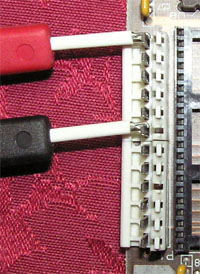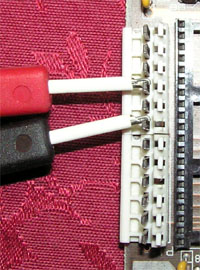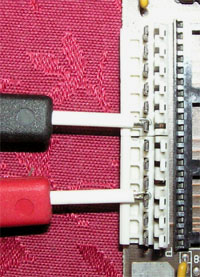
If your motherboard measures zero or a few ohms, then there is definitely a short-circuit on the +5 volt line.
In either case, click HERE
| IMPORTANT: | Do NOT use the continuity setting on your multimeter. Use the resistance setting. |

 |
On the many good 5150/5155/5160 motherboards that I have, this measurement ranges in value from about 200 ohms up to about 1300 ohms. If your motherboard measures zero or a few ohms, then there is definitely a short-circuit on the +5 volt line. In either case, click HERE |
 |
On the many good 5150/5155/5160 motherboards that I have, this measurement is so high that it it is beyond the capability of my multimeter. Initially, you may see a reading of some sort that slowly rises (as capacitors charge) but in the end, expect to see no reading. If your motherboard measures zero or a few ohms, then there is definitely a short-circuit on the -5 volt line. In either case, click HERE |
 |
On the many good 5150/5155/5160 motherboards that I have, this measurement is so high that it it is beyond the capability of my multimeter. Initially, you may see a reading of some sort that slowly rises (as capacitors charge) but in the end, expect to see no reading. If your motherboard measures zero or a few ohms, then there is definitely a short-circuit on the +12 volt line. In either case, click HERE |
 |
On the many good 5150/5155/5160 motherboards that I have, this measurement is so high that it it is beyond the capability of my multimeter. Initially, you may see a reading of some sort that slowly rises (as capacitors charge) but in the end, expect to see no reading. If your motherboard measures zero or a few ohms, then there is definitely a short-circuit on the -12 volt line. In either case, click HERE |